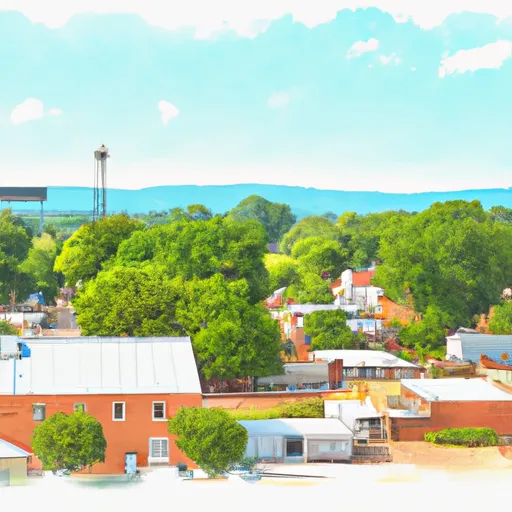-
 Snoflo Premium
Snoflo Premium
Get unlimited access to all our content
With no Ad interruptions! - Start Your Free Trial Login with existing account
Sulphur-Springs
Eden Index
Climate
8.2
•
Recreation
4.5
•
Community
•
Safeguard
4.9/10

Sulphur Springs is a small town located in Benton County, Arkansas. Known for its picturesque landscapes and natural beauty, the town experiences a humid subtropical climate. Summers are hot and humid, with temperatures often reaching the mid-90s Fahrenheit, while winters are mild, with average temperatures ranging from the mid-30s to the mid-50s.
The town is surrounded by numerous water resources, with the Illinois River and its tributaries being the primary hydrological constituents. These water sources provide opportunities for various recreational activities such as fishing, kayaking, and canoeing. The Illinois River is particularly renowned for its scenic beauty and is a popular destination for outdoor enthusiasts.
In addition to water-based activities, Sulphur Springs offers a range of outdoor recreation opportunities. The town is surrounded by lush forests that are ideal for hiking, camping, and wildlife observation. Nearby state parks, such as Devil's Den State Park and Hobbs State Park Conservation Area, offer extensive trail systems, picnic areas, and camping facilities for visitors to enjoy.
Overall, Sulphur Springs, Arkansas, offers a favorable climate, abundant water resources, and diverse outdoor recreational opportunities, making it an appealing destination for nature lovers and adventure seekers.
What is the Eden Index?
The Snoflo Eden Index serves as a comprehensive rating system for regions, evaluating their desirability through a holistic assessment of climate health, outdoor recreation opportunities, and natural disaster risk, acknowledging the profound impact of these factors on livability and well-being.
Climate Health Indicator (CHI): 8.2
Sulphur-Springs receives approximately
1150mm of rain per year,
with humidity levels near 80%
and air temperatures averaging around
15°C.
Sulphur-Springs has a plant hardyness factor of
6, meaning
plants and agriculture in this region thrive during a short period during spring and early summer. Most
plants will die off during the colder winter months.
By considering the ideal temperature range, reliable water supplies, clean air, and stable seasonal rain or snowpacks, the Climate Health Indicator (CHI) underscores the significance of a healthy climate as the foundation for quality living.
A healthy climate is paramount for ensuring a high quality of life and livability in a region, fostering both physical well-being and environmental harmony. This can be characterized by ideal temperatures, reliable access to water supplies, clean air, and consistent seasonal rain or snowpacks.
Weather Forecast
Streamflow Conditions
Neosho
Area Rivers
Neosho
Snowpack Depths
Neosho
Reservoir Storage Capacity
Neosho
Groundwater Levels
Recreational Opportunity Index (ROI): 4.5
The Recreational Opportunity Index (ROI) recognizes the value of outdoor recreational options, such as parks, hiking trails, camping sites, and fishing spots, while acknowledging that climate plays a pivotal role in ensuring the comfort and consistency of these experiences.
Access to outdoor recreational opportunities, encompassing activities such as parks, hiking, camping, and fishing, is crucial for overall well-being, and the climate plays a pivotal role in enabling and enhancing these experiences, ensuring that individuals can engage in nature-based activities comfortably and consistently.
Camping Areas
| Campground | Campsites | Reservations | Toilets | Showers | Elevation |
|---|---|---|---|---|---|
| Queen Wilhelmina State Park | None | 2,521 ft | |||
| Blue Springs County Campground | 82 | 867 ft | |||
| Little Pines | 9 | 805 ft | |||
| Adair State Park | None | 1,100 ft | |||
| Natural Falls State Park | None | 1,079 ft | |||
| Winding Stair | 23 | 1,961 ft | |||
| Lee Creek Public Use Area | None | 401 ft | |||
| Lake Wedington Rec. Area | 152 | 1,131 ft | |||
| Fort Chaffee RV Military | None | 448 ft | |||
| Lanagan Access City Park | None | 851 ft |
Catastrophe Safeguard Index (CSI):
The Catastrophe Safeguard Index (CSI) recognizes that natural disaster risk, encompassing floods, fires, hurricanes, and tornadoes, can drastically affect safety and the overall appeal of an area.
The level of natural disaster risk in a region significantly affects safety and the overall livability, with climate change amplifying these risks by potentially increasing the frequency and intensity of events like floods, fires, hurricanes, and tornadoes, thereby posing substantial challenges to community resilience and well-being.
Community Resilience Indicator (CRI):
The Community Resilience Indicator (CRI) recognizes that education, healthcare, and socioeconomics are crucial to the well-being of a region. The CRI acknowledges the profound impact of these elements on residents' overall quality of life. By evaluating educational resources, healthcare accessibility, and economic inclusivity, the index captures the essential aspects that contribute to a thriving community, fostering resident satisfaction, equity, and social cohesion.

